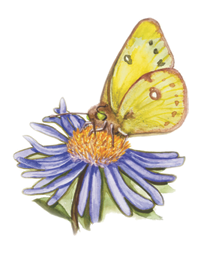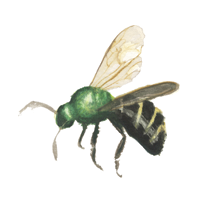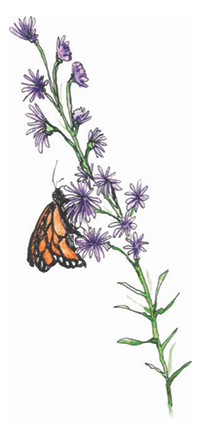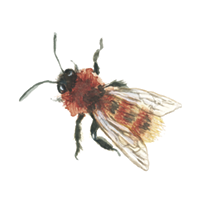
Gardening for Bees and Butterflies
How to create a garden that welcomes beneficial pollinators.
by Sharon Parker | illustrations by Sharon Parker
 To enjoy butterflies and bees in your surroundings, you need to do more than plant the flowers and other plants that they like. You must also adopt practices that foster a healthy ecosystem for all the critters—the native bees and beetles; the tiny crawlers in the soil; the birds. If you attract butterflies and bees with flowers, only to kill them with your yardwork, you could be doing more harm than good.
To enjoy butterflies and bees in your surroundings, you need to do more than plant the flowers and other plants that they like. You must also adopt practices that foster a healthy ecosystem for all the critters—the native bees and beetles; the tiny crawlers in the soil; the birds. If you attract butterflies and bees with flowers, only to kill them with your yardwork, you could be doing more harm than good.
START BY TAKING CARE OF THE SOIL
Healthy soil leads to healthy plants, which means you won’t be so likely to be tempted to reach for the pesticides. Also, underground lies an important habitat for many beneficial critters, including some pollinators.
Return nutrients to the soil with compost. Home compost can include vegetable scraps, coffee grounds and tea leaves (more info).
DON’T TILL – LET NATURE DO THE WORK FOR YOU
Tilling and turning the soil breaks up large particles and destroys air pockets, leading to soil compaction, and disturbs the worms, ground-nesting bees, and assorted other organisms that are needed for healthy soil. Apply compost and organic fertilizer to the surface – there’s no need to dig it in; soil-dwelling organisms will mix it in for you.
Shallow hoeing and scratching the surface is fine, it’s the deep digging and mechanical tilling that does the harm.
Mulch naturally—but not too much. A natural organic mulch, like leaves, shredded wood, or grass clippings, is great for discouraging weeds and preventing soil from drying out; it also keeps dirt from splashing on leaves, which can help prevent the spread of soil-borne pathogens.
However, too much mulch, especially when combined with an impenetrable weed barrier, obstructs solitary bees, who emerge from the ground in the spring and deposit their eggs in tiny underground tunnels in early summer. Let your mulch be a little thin in spots, and leave some bare soil here and there.
Solitary bees are important pollinators, and harmless; they rarely (if ever) sting, and their stingers are much smaller than those of bigger bees.
Butterflies also need access to bare soil, as many of them gather minerals from mud. Consider keeping a shallow dish with dirt in it on the ground somewhere, like near a bird bath or flower pots, where you can wet it from time to time.
PROVIDE FOR GOOD AIR CIRCULATION
Let the breezes waft through your garden to speed evaporation and discourage mold and mildew, which thrive in damp, still conditions. Find out which way the prevailing summer winds blow in your area, and try to arrange your plantings with that in mind, so they are open to those summer breezes.
MATCH PLANTS WITH THE SUNLIGHT THEY NEED
If a plant isn’t getting enough sun, it will tend to grow weak and spindly, and will lean rather than stand up straight. Weakened plants are more prone to getting diseases and attracting problem insects. If your flowers are leaning and appear to have weak stems, or if they get mildew or leaf spots, they may need to be moved to a spot where they get more sun—six hours or more in most cases.
The timing of sunlight can be just as important as the quantity. Leaves that are shaded in the morning remain damp well into the day, often until the sun shines on them. Put any plants that are susceptible to foliar diseases where they’ll get morning sun. Many roses, for example, can thrive on as little as four hours of sun if they get most of it in the morning.
LEARN TO STOP WORRYING AND LOVE IMPERFECTION
A healthy garden is going to have a few weeds and plants with spots and holes in them. Rather than striving for a perfect garden, seek balance instead.
When the weeds begin to overwhelm you, especially during the hottest days of summer, selectively cut down or pull the tallest weeds that are crowding vulnerable plants (see “air circulation,” above), and otherwise just edge the garden by creating a shallow ditch with a straight shovel or old-style edger. You’ll find that it looks much nicer with tidy edges.
Don’t worry about the weeds in your lawn. Many common lawn weeds, like clover, violets, and dandelions, are food for butterflies and bees—the nectar and pollen for adult insects, and the leaves for caterpillars. Some taller flowering weeds could be allowed to grow in a little cluster in a discreet corner of your yard. Think of it as a garden for the fairies.
A garden with a variety of pollinator-friendly flowers and practices will attract other beneficial creatures as well, some of which will prey on the problem insects and keep them from taking over. Helpful predators include some that you may find a bit frightening until you get to know them—like wasps, ground beetles, centipedes, and spiders.
 LEAVE THE LEAVES
LEAVE THE LEAVES
In fall, limit your garden cleanup to the removal of diseased or disease-prone plants, and leave the leaves that fall on gardens and around trees and shrubs. Let erect plant stems and seed heads stand until spring, when new growth starts. The seeds are winter food for the birds, and some of the stems may have a butterfly chrysalis attached to them, looking so inconspicuous that you are likely to mistake it for a curled leaf. Hollow stems could also be home to solitary native bees: some lay their eggs in the ground, others use hollow stems and twigs, or holes in old rotting wood.
As for the leaves, just rake the ones that fall on the lawn over to nearby shrubs and gardens. Fallen leaves may contain the eggs, pupae, larvae or chrysalises of butterflies; if you burn them, shred them, or bag them, the critters will not survive. Butterflies lay their eggs on or near the plants that the caterpillars will need to eat, so the more you keep fallen leaves near their source, the better.
. . . . . . . . . . . . . . . . . . . . . . . . . . . . . . . . . . .
Sharon Parker is an artist, crafter, grandmother, urban gardener, and nature nerd who blogs at SharonsCompendium.com.
. . . . . . . . . . . . . . . . . . . . . . . . . . . . . . . . . . .
Why welcome pollinators to your garden?
|